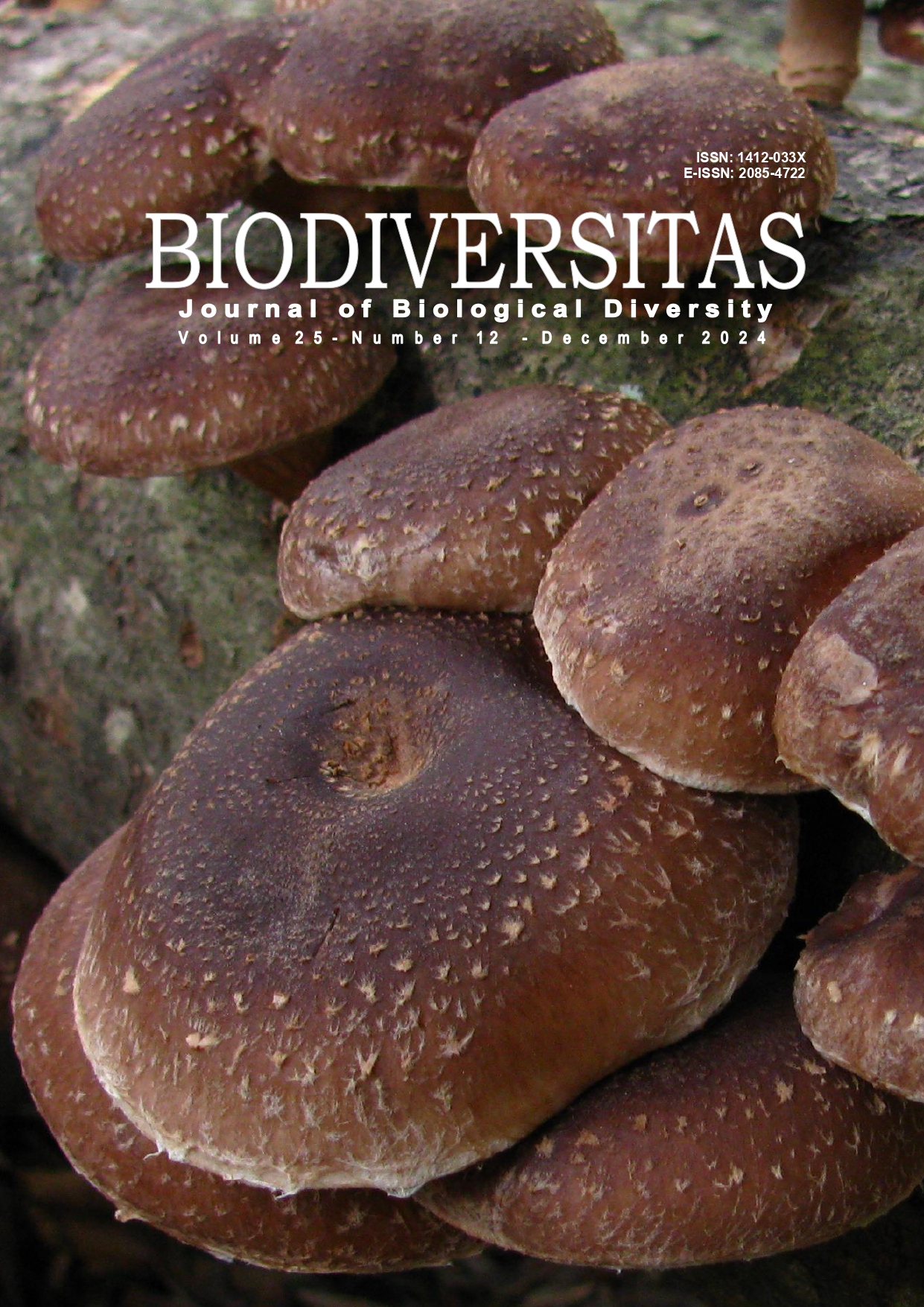Impact of genotype and harvest age on the polyphenol content and antioxidant capacity of okra (Abelmoschus esculentus) in Indonesia
##plugins.themes.bootstrap3.article.main##
Abstract
Abstract. Liwanda N, Syukur M, Nurcholis W. 2024. Impact of genotype and harvest age on the polyphenol content and antioxidant capacity of okra (Abelmoschus esculentus) in Indonesia. Biodiversitas 25: 4920-4929. Consuming bioactive compounds like polyphenols and flavonoids is crucial for reducing the risk of diseases due to their antioxidant, antibacterial, and anticancer properties. Okra (Abelmoschus esculentus), a widely cultivated vegetable known for its nutritional benefits, remains underutilized in Indonesia. This study aimed to identify the optimal genotype and harvest age of okra to maximize total phenolic content (TPC), total flavonoid content (TFC), and antioxidant capacity. Ten okra genotypes were evaluated, with a focus on the impact of harvest age on four selected genotypes. The G7 genotype (F7 Clemson × Stripe-3-10-15B) exhibited the highest TPC (0.98 mg gallic acid equivalent/g fresh weight), TFC (0.35 mg quercetin equivalent/g fresh weight), and antioxidant capacity (5.13 µmol Trolox equivalent/g fresh weight). The optimal harvest age was determined to be the 7th day after anthesis, yielding the highest TPC and TFC values, ranging from 0.31 to 0.98 mg GAE/g and 0.19 to 0.35 mg QE/g, respectively. These findings indicate that both genotype and harvest age significantly affect the polyphenol content and antioxidant capacity of okra, with the G7 genotype and the 7th day after anthesis being optimal for maximizing bioactive compounds. This study highlights the potential for developing superior okra varieties in Indonesia.
##plugins.themes.bootstrap3.article.details##
Most read articles by the same author(s)
- WARAS NURCHOLIS, NURUL KHUMAIDA, MARIA BINTANG, MUHAMAD SYUKUR, GC-MS analysis of rhizome ethanol extracts from Curcuma aeruginosa accessions and their efficiency activities as anticancer agent , Biodiversitas Journal of Biological Diversity: Vol. 22 No. 3 (2021)
- JANSON CALVINDI, MUHAMAD SYUKUR, WARAS NURCHOLIS, Investigation of biochemical characters and antioxidant properties of different winged bean (Psophocarpus tetragonolobus) genotypes grown in Indonesia , Biodiversitas Journal of Biological Diversity: Vol. 21 No. 6 (2020)
- ARYA WIDURA RITONGA, M. ACHMAD CHOZIN, MUHAMAD SYUKUR, AWANG MAHARIJAYA, SOBIR SOBIR, Short Communication: Genetic variability, heritability, correlation, and path analysis in tomato (Solanum lycopersicum) under shading condition , Biodiversitas Journal of Biological Diversity: Vol. 19 No. 4 (2018)
- MUHARAMA YORA, MUHAMAD SYUKUR, SOBIR SOBIR, Characterization of phytochemicals and yield components in various okra (Abelmoschus esculentus) genotypes , Biodiversitas Journal of Biological Diversity: Vol. 19 No. 6 (2018)
- NURUL KHUMAIDA, MUHAMAD SYUKUR, MARIA BINTANG, WARAS NURCHOLIS, Phenolic and flavonoid content in ethanol extract and agro-morphological diversity of Curcuma aeruginosa accessions growing in West Java, Indonesia , Biodiversitas Journal of Biological Diversity: Vol. 20 No. 3 (2019)
- TRI WAHONO DYAH AYU SAYEKTI, MUHAMAD SYUKUR, SRI HENDRASTUTI HIDAYAT, AWANG MAHARIJAYA, Morphological response and genetic variability of four species of chili pepper (Capsicum spp.) under infection of pepper yellow leaf curl virus , Biodiversitas Journal of Biological Diversity: Vol. 22 No. 11 (2021)
- RIZKI FITRIA, DJAROT SASONGKO HAMI SENO, BAMBANG PONTJO PRIOSOERYANTO, HARTANTI, WARAS NURCHOLIS, Volatile compound profiles and cytotoxicity in essential oils from rhizome of Curcuma aeruginosa and Curcuma zanthorrhiza , Biodiversitas Journal of Biological Diversity: Vol. 20 No. 10 (2019)
- TRI WAHONO DYAH AYU SAYEKTI, MUHAMAD SYUKUR, SRI HENDRASTUTI HIDAYAT, AWANG MAHARIJAYA, Diversity and genetic parameter of chili pepper (Capsicum annuum) based on yield component in three location , Biodiversitas Journal of Biological Diversity: Vol. 22 No. 2 (2021)
- ZULFIKAR DAMARALAM SAHID, MUHAMAD SYUKUR, AWANG MAHARIJAYA, WARAS NURCHOLIS, Quantitative and qualitative diversity of chili (Capsicum spp.) genotypes , Biodiversitas Journal of Biological Diversity: Vol. 23 No. 2 (2022)
- INDAH PURNAMASARI, SOBIR SOBIR, MUHAMAD SYUKUR, Diversity and inheritance in cowpea (Vigna unguiculata) on protein and yield components characters , Biodiversitas Journal of Biological Diversity: Vol. 20 No. 5 (2019)

